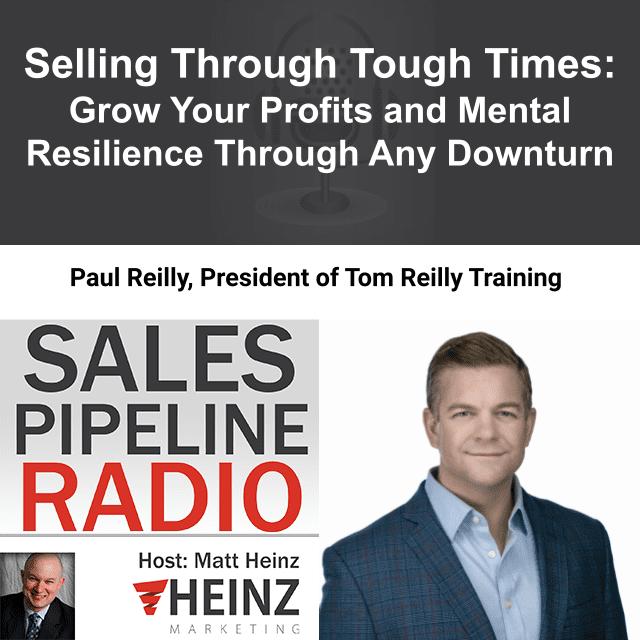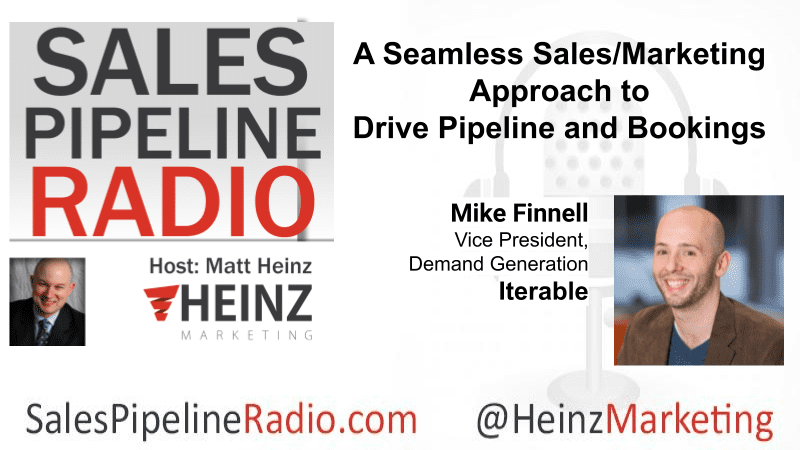Sales Pipeline Radio, Episode 323: Q & A with Paul Reilly @PaulReillyVAS

By Matt Heinz, President of Heinz Marketing
If you’re not already subscribed to Sales Pipeline Radio, or listening live every Thursday at 11:30 a.m Pacific on LinkedIn (also on demand) you can find the transcription and recording here on the blog every Monday morning. The show is less than 30 minutes, fast-paced and full of actionable advice, best practices and more for B2B sales & marketing professionals.
We cover a wide range of topics, with a focus on sales development and inside sales priorities. You can subscribe right at Sales Pipeline Radio and/or listen to full recordings of past shows everywhere you listen to podcasts! Spotify, iTunes, Blubrry, Google Play, iHeartRADIO, Stitcher and now on Amazon music. You can even ask Siri, Alexa and Google!
This week’s show is entitled, “Selling Through Tough Times: Grow Your Profits and Mental Resilience Through Any Downturn“ and my guest is Paul Reilly, President of Tom Reilly Training and author of “Selling Through Tough Times, Grow your profits and mental resilience through any downturn”
Tune in to hear more about:
- What makes for successful, resilient sellers
- Adopting a positive first response to adversity
- Positive reframing and messaging pivots for sellers and marketers
Listen in now for this and MORE, watch the video or read the transcript below:
Matt: All right. Well, welcome everybody to another episode of Sales Pipeline Radio. My name is Matt Heinz. I’m your host. Excited to have you here.
If you are listening or watching on demand, thank you very much for downloading and subscribing to our Sales Pipeline Radio episodes. Every episode of Sales Pipeline Radio past, present, future always available at salespipelineradio.com.
Every week we’re featuring some of the best and brightest minds in sales and marketing, specifically in B2B. Today’s episode no different. Very excited to have with us, Paul Reilly, a multi-time author, number one, best-selling author of multiple books around sales, “Value-Added Selling.” And the more recent books selling highly relevant right now, “Selling Through Tough Times.”
Paul, thanks so much for joining us.
Paul: Matt, it is a privilege. And the only thing hotter than Seattle today is going to be the messaging our interview today. So let’s make it happen, man. Thanks for having me.
Matt: Oh, my goodness. Listen to that one. We’re coming in hot. All right. So for those that don’t know you, and I know we’ve got a mixed audience here, marketing sales folks, for those that haven’t read some of your books in the past, give a little bit of your background and sort of what you do.
Paul: Yeah, absolutely. So I’m a salesperson at heart. I mean, my first job was a sales job. My first professional job, we’ll call it, was selling propane for a company called Feral Gas. I’m selling in the B2B space here for industrial use. Interesting profession because I am selling literally the same product as the two dozen competitors that are out there selling as well. So very challenging environment.
I also sold during that timeframe when King of the Hill was at its height of popularity, that show where Hank hill sold propane. So I was Hank Hill. Loved that sales job. Great company to work for. From there, I went to go work with Hilti selling tools and fasteners in the construction industry. Hilti is a premium name. They are a premium brand. So I was selling a product that was sometimes 20, 30, even 50% higher than the competition. So I had to learn how to compete on value.
And then I sold medical equipment for a few years before I got into the speaking and training business. And the one commonality between all of those different industries was that customers want value. They want value. So that was how I got started in sales. And then today what I do is I travel the globe helping sales organizations compete more profitably by selling on value and not price. And I do that through training seminars, keynote presentations, and consulting as well. So, that’s what I do.
Matt: Love it. Well, I can’t remember where I came about you in years past. Certainly read “Value-Added Selling.” A great book. You host a great podcast of your own “Q and A Sales.” And I found this new book particularly relevant right now.
I mean, you get all kinds of mixed messages in the market this year. You got some companies doing layoffs, you got inflation, then we’re in a bull market. We’re in a fair market. We’re back to a bull market. Who knows what’s happening. What I do know, having talked to a lot of our clients and people in my network, as well as we grow in our business and sell is that this has been a very interesting year. Demand is still there. Interest is still there. Getting commitment and closing has been a challenge for a lot of companies this year. And I know you’re seeing some of that as well.
So talk a little bit about the conditions. I want to get into the idea of mental resilience and some of the stuff that’s in the new book. But talk about the conditions you are seeing in the market today. What’s real?
Paul: So, certainly all the factors that you just mentioned, the big one as of recently that we are technically in a recession. With two consecutive quarters of negative GDP that puts us into a recession. So what I’m seeing is buyers, in general, are starting to become a little more hesitant. They’re pumping the brakes a little bit. They want to see what this recession feels like. If it’s a short one, if it’s a long one.
So, we still see supply chain constraints across the board. Labor shortages are still there, inflation, rising interest rates. So there’s a lot of uncertainty. If we could just lump everything into that one factor, uncertainty. And a few things happen when there’s uncertainty. Buyers, they pump the brakes. They start to focus more on cost cutting measures as well. And they’re filled with fear and anxiety. They may not vocalize it, but that’s certainly part of how they think.
So, I see all those factors. But the good news is, Matt, I can’t think of a better profession to handle uncertainty than sales people. We face it all the time. Nothing is guaranteed. Same with marketers. Nothing is guaranteed. We really have to operate in the market in whatever the environment is and figure out a way to make things happen.
Matt: Well, in the best of markets people stop buying. In the best of markets people decide not to buy fuel. And in the worst of markets, people still buy. Every one of us is trying to find a way to continue to move forward. And that in many cases includes investing in and committing to certain solutions and outcomes.
As a seller from an approach standpoint, I mean, we’ve all been through 2008, 2020. We’ve seen economic conditions shift and challenge the selling environment. What are things you’re seeing successful, resilient sellers do right now?
Paul: First things first. They mentally prepare themselves every day to go out there and do their best, focus on what they can control. That was one thing that I felt was extremely important in this book is to highlight the mental aspect of what it means to be in sales.
There are plenty of self-help books out there. There are plenty of books out there focusing on resilience. Some great books that I absolutely love. But what makes this unique is that it’s written from the perspective of a salesperson, in what we uniquely face. We could do everything right on a sales call and still they don’t buy. We have to face that uncertainty every day. And so, in the book, we talk a lot about ways that we can build mental resilience and techniques. And we call it positive mental programming. That’s really what it is all about is programming yourself every single day to go out there, focus on what you can control, focusing more on progress than performance.
And I know that can be a sticky situation, a tough conversation, especially with sales leaders. But let’s face it, during tough times there’s going to be a drop off in business activity. And so during tough times, we need to focus more on the progress that we’re making purely than just performance. I’m not saying we throw out performance metrics and all that, no. But we need to focus on just making that progress.
Matt: This idea of mental resilience, I mean, it’s really important now. But again, even in the best of selling conditions, the vast majority of your prospects end up saying no. When you think about prospects to opportunities to close deals, this is a sales funnel not a sales cylinder. And so there’s resilience just in all of those no’s you get, even in the best of selling conditions. What are some keys to developing that mental resilience in all economic conditions?
Paul: Absolutely. So I would say one of the first things we can do, number one, is to develop a positive first response to adversity. Okay? So Matt, let’s think about this. I believe people fall into three categories when it comes to handling adversity, tough moments. You have people that experience them and they push right through them. It’s doesn’t even slow them down. It’s almost like they generate more momentum. They love the challenge.
Now, on the opposite end of that, you’ve got people who experience adversity and they quickly give up. I doubt anyone listening to this podcast falls into that category. But here’s where most people fall into. It’s the third category. They face some adversity, they complain about it. They wallow around in self-pity to various degrees. They get frustrated and they pause and then they wait it out. And then eventually they push through.
And my thought is, “Okay, if you’re going to push through eventually, why not do it sooner rather than later?” So here’s the tip on how you can develop that positive first response. And it’s very simple. Start with one day. For one day track all of the adverse things that have happened to you. Begin tracking them. And as you track them, look at your first response. And it could be something simple like, “Oh, that customer called me and said they’re going in a different direction.” That’s a tough time right there. How do you respond? Do you spend five minutes complaining about it? 20 minutes? Whatever it is. Track the response.
Let’s say, next thing happens, your shoelace breaks. Something stupid, but it’s adversity. How do you respond? Do you complain about it? How do you feel, sorry for yourself? Whatever it is. And what’s going to happen as you track your response to adversity, you are going to begin to self-correct. You’re going to notice it, how you respond and you’re not going to like the way you respond. So you will naturally change. So that’s one thought. Developing that positive first response to adversity is key. How you do it is by just tracking your response. Start with a day, then do the next day. Do it for a week. And what you’re going to notice over that week is that you become more resilient. You start to bounce back quicker.
Matt: And these are habits, I mean, that you’re building over time. And the benefit of doing this whether you’re in sales or marketing or accounting, is we all face resilience challenges in our work, in our life. And so I like the idea of building that muscle and that habit with things that are big and small, because they all matter in terms of how your brain ultimately responds to stimulus and situations around you.
Paul: Absolutely. And if I could build on that, Matt, just for one more thought, in the book, you’ll notice I use the phrase, “tough times are good,” repeatedly. They are good. And they’re good because of the positive change that they can generate.
Now, part of the message in positive mental programming is a technique we call positive reframing. Every single day negative things happen. That’s just a reality of participating in this world. But you get to choose how you respond. And one of the tools we have, we call it the daily mental flex. It’s a collection of six exercises to help you develop that mental resilience. And one of the exercises is called positive reframing.
Throughout the day or at the end of the day, think of a negative event that has happened. And then what you need to do is ask yourself, “Okay, what’s the positive outcome that could potentially happen as a result of this. What’s a good thing that will happen? What’s the silver lining on this cloud?” And what you end up doing daily as you build that habit, as you mentioned, you train your brain to almost automatically default to the good things that will happen through the negative events. And you think about how much more opportunity you will see as a salesperson, as a marketer, if you choose to view the world in that way. So that positive reframing is critical as we go through tough times.
Matt: I’ve got a couple last questions before we wrap up here. Check out toughtimer.com. You can learn more about the book, get more information from Paul. Talk a little about the tough timer challenge and this daily mental reflect challenge you have because I thought that was really cool.
Paul: Yeah, absolutely. So we call it the 30-day tough timer challenge. And the goal is to build your mental strength. I think the CDC recommends 25 to 30 minutes of physical activity a day to build your physical strength. What if we dedicated as much time and effort to building our mental strength? And that’s what the tough timer challenge is.
It’s a collection of six exercises, mental exercises that you will do daily for 30 days. And for 30 days you’re going to notice some positive changes in your life. You’re going to be more grateful for what you do have. You’re going to be able to develop a stronger self-discipline. You’re going to be able to continuously improve every single day. Doing this over 30 days, there’s an exponential benefit that you will gain just from going through these exercises.
And they don’t take that long. That’s the beauty. I mean, we’re talking 10 to 15 minutes in the morning and maybe another 10 to 15 minutes in the evening. But there are six exercises, expressing gratitude, continuous improvement, self-discipline, positive reframing, pruning and planting, which is about removing negativity. And then finally reducing friction between your goals. So those are really the six exercises.
But I don’t want to discourage anyone from trying it, but Matt, I’ll tell you that most people won’t do it. They won’t do it for 30 days. They may try and that’s okay. What I would encourage you to do is at least get started with it and try it for a week. I’d try it for a week and then ask yourself after a week, “Do I feel like I’m a better person? Am I a better version of myself than I was seven days ago?” If the answer is, “Yes,” keep going.
Matt: Well, on the outcomes and the improvements you make for yourself personally. I mean, I think as a seller, it helps you be more professional, more poised, confidence without ego and resilient through good times and bad. As a leader, it helps you lead your team and exhibit leadership qualities that other people are going to exhibit. And then last, I wish I knew about this earlier in my career. As I dig into the book and the models you have, I think about the way I reacted to things in my career and my job stress that was entirely unproductive and probably even had a negative impact. And the earlier you can develop these skill, I think the better you can be in any role that you have.
Speaking of that, last question I have for you. We’ve got a mix of sales and marketing professionals that are listening to and watching this show on a weekly basis. This is a book that is in its title about selling. But I read this book and I thought it was highly very important for marketers. What do you think marketing professionals and marketing counterparts to sales can learn or should be learning from this book?
Paul: Yeah, absolutely. Sales and marketing are so linked. I believe that selling exists to execute tactically what marketing designs strategically. So sales people are out, boots on the ground, making it happen, but they rely on marketing and vice versa. This book is chucked full of marketing tips and ideas, especially around customer messaging.
So from a marketing standpoint, as we go through tough times, there’s a few things that we need to control messaging wise. Number one, people become more focused on cost cutting ideas during tough times. So from a marketing perspective, I would encourage every marketer listening to go back and take a look at their solution and detail how their solution helps cut cost, overall cost, not price. So keep that distinction there. The difference between price and cost. But also cash flow, especially if you’re selling to small businesses, marketing to small businesses, but even big corporations. Cash flow is lifeblood for any organization, but especially through tough times. It’s similar to oxygen. So if you can impact cash flow with your solution, that’s going to be critical.
Another piece that becomes so important, and you see a lot of big companies do this in their marketing, longevity, certainty, and stability are important in your messaging during tough times. And the reason why companies want to partner with other companies that have been through tough times, that have proven themselves, that have gone through a recession and a depression in certain cases- in a recent sales kickoff meeting, a salesperson asked, “Paul, do our customers really care that we’ve been around for a hundred plus years?” I said, “Right now they do.” If you’ve been through the great depression and you’ve survived that and the pandemic of the Spanish flu and you’ve survived that, and you’ve survived multiple recessions, inflation, things like that, it proves that your company is going to be here. And people need that stability.
Chevy’s, “like a rock” campaign, which aired in early 1990s, knew that stability was important especially at that point in time. They actually launched that campaign in the middle of a recession. And I have to believe part of it was the marketing team thought, “Okay, people are in a recession right now. They need something that is stable.” And that turned out to be one of their most popular ad campaigns. It certainly lasted longer than the recession did. So stability is so important.
Matt: All right. If you are listening to this on demand, I want you to rewind three to four minutes and listen to what Paul just said again, because that was packed with some really important messaging pivots. Whether you’re in sales, whether you’re in marketing, your customers are still buying, but the criteria they’re using and the messages they hear that are going to get them to commit the change in this moment, in tough markets, has pivoted. Super important.
Paul, thank you so much for joining us on Sales Pipe Radio today. Obviously, Amazon, tough timer. Where else can people learn more about you?
Paul: Yeah, I would say just go to toughtimer.com. And I’ve got a bonus for marketers and sellers. Chapter 14 of this book, which is crafting your customer message. It’s actually Mike Weinberg’s favorite chapter. He wrote the foreword to the book. I know he’s been on your show as well. You can get it for free. You can download it for free at toughtimer.com. Just go to the book tab at the top of the website and then you just enter your email address and you’ll get that chapter for free, Chapter 14.
Matt: Awesome. Well, thank you, everyone, for watching and listening. We’ll be here again next week, Thursday, 11:30 Pacific, 2:30 Eastern. My name is Matt Heinz. We’ll see you next week.
Listen to the Latest Episodes:






